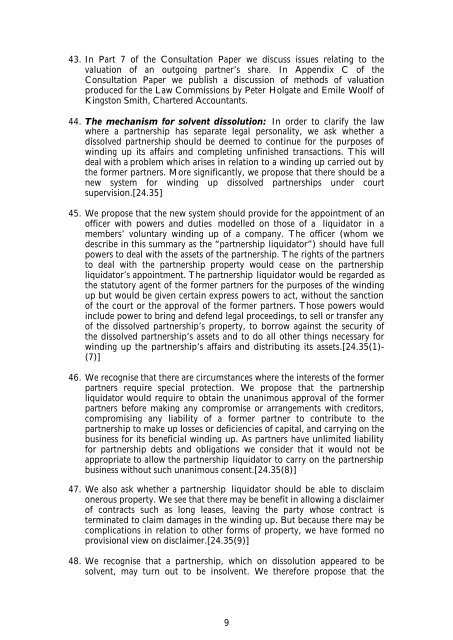Partnership Law Consultation Summary - Law Commission
Partnership Law Consultation Summary - Law Commission
Partnership Law Consultation Summary - Law Commission
You also want an ePaper? Increase the reach of your titles
YUMPU automatically turns print PDFs into web optimized ePapers that Google loves.
43. In Part 7 of the <strong>Consultation</strong> Paper we discuss issues relating to the<br />
valuation of an outgoing partner’s share. In Appendix C of the<br />
<strong>Consultation</strong> Paper we publish a discussion of methods of valuation<br />
produced for the <strong>Law</strong> <strong>Commission</strong>s by Peter Holgate and Emile Woolf of<br />
Kingston Smith, Chartered Accountants.<br />
44. The mechanism for solvent dissolution: In order to clarify the law<br />
where a partnership has separate legal personality, we ask whether a<br />
dissolved partnership should be deemed to continue for the purposes of<br />
winding up its affairs and completing unfinished transactions. This will<br />
deal with a problem which arises in relation to a winding up carried out by<br />
the former partners. More significantly, we propose that there should be a<br />
new system for winding up dissolved partnerships under court<br />
supervision.[24.35]<br />
45. We propose that the new system should provide for the appointment of an<br />
officer with powers and duties modelled on those of a liquidator in a<br />
members’ voluntary winding up of a company. The officer (whom we<br />
describe in this summary as the “partnership liquidator”) should have full<br />
powers to deal with the assets of the partnership. The rights of the partners<br />
to deal with the partnership property would cease on the partnership<br />
liquidator’s appointment. The partnership liquidator would be regarded as<br />
the statutory agent of the former partners for the purposes of the winding<br />
up but would be given certain express powers to act, without the sanction<br />
of the court or the approval of the former partners. Those powers would<br />
include power to bring and defend legal proceedings, to sell or transfer any<br />
of the dissolved partnership’s property, to borrow against the security of<br />
the dissolved partnership’s assets and to do all other things necessary for<br />
winding up the partnership’s affairs and distributing its assets.[24.35(1)-<br />
(7)]<br />
46. We recognise that there are circumstances where the interests of the former<br />
partners require special protection. We propose that the partnership<br />
liquidator would require to obtain the unanimous approval of the former<br />
partners before making any compromise or arrangements with creditors,<br />
compromising any liability of a former partner to contribute to the<br />
partnership to make up losses or deficiencies of capital, and carrying on the<br />
business for its beneficial winding up. As partners have unlimited liability<br />
for partnership debts and obligations we consider that it would not be<br />
appropriate to allow the partnership liquidator to carry on the partnership<br />
business without such unanimous consent.[24.35(8)]<br />
47. We also ask whether a partnership liquidator should be able to disclaim<br />
onerous property. We see that there may be benefit in allowing a disclaimer<br />
of contracts such as long leases, leaving the party whose contract is<br />
terminated to claim damages in the winding up. But because there may be<br />
complications in relation to other forms of property, we have formed no<br />
provisional view on disclaimer.[24.35(9)]<br />
48. We recognise that a partnership, which on dissolution appeared to be<br />
solvent, may turn out to be insolvent. We therefore propose that the<br />
9

















